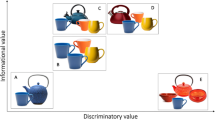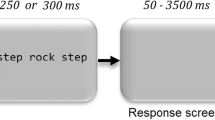Abstract
Tasks which assess children's speaker skills in the referential communication paradigm frequently mark the target item in some way to indicate which picture should be described. It was hypothesized that this procedure would interfere with effective scanning of the visual array (comparison processing) assumed to be necessary for the production of accurate messages. It was also predicted that, when one item was highlighted, more redundant features would be included in messages. An experiment which compared a marked with an unmarked target condition across three age ranges (6, 8, 10 years) found that message accuracy was not affected by highlighting. But significantly more redundant features were reported in the marked condition, indicating that, where redundancy is the focus of interest, a highlighting procedure should be avoided. Two age effects were also found: Message accuracy improved with age, while redundancy reduced with age.
Similar content being viewed by others
REFERENCES
Asher, S. R. (1976). Children's ability to appraise their own and another person's communication performance. Developmental Psychology, 12, 24–32.
Bearison, D. J., & Levey, L. M. (1977). Children's comprehension of referential communication: Decoding ambiguous messages. Child Development, 48, 716–720.
Bishop, D. V., & Adams, C. (1991). What do referential communication tasks measure? A study of children with specific language impairment. Applied Psycholinguistics, 12, 199–215.
Hall, L. (1990). Children's perception. In R. Grieve & M. Hughes (Eds.), Understanding children. Oxford, England: Blackwell.
Lloyd, P. (1989). El desarrollo de las habilidades de comunicacion y la deteccion de la ambiguedad. In E. Turiel, I. Enesco & J. Linaza (Eds.), El munda social en la mente infantil. Madrid, Spain: Alianza Psicologia.
Lloyd, P. (1990). Children's communication. In R. Grieve & M. Hughes (Eds.), Understanding children. Oxford, England: Blackwell.
Lloyd, P., & Beveridge, M. (1981). Information and meaning in child communication. London: Academic Press.
Olson, D. (1970). Language and thought: Aspects of a cognitive theory of semantics. Psychological Review, 77, 257–273.
Patterson, C. J., Cosgrove, J. M., & O'Brien, R. G. (1980). Nonverbal indicants of comprehension and noncomprehension in children. Developmental Psychology, 16, 38–48.
Shatz, M. (1978). The relationship between cognitive processes and the development of communication skills. In H. E. Howe & C. B. Keasey (Eds.), Nebraska Symposium on Motivation, 1977. Lincoln: University of Nebraska Press.
Sonnenschein, S. (1984a). Why young listeners do not benefit from differentiating verbal redundancy. Child Development, 55, 929–935.
Sonnenschein, S. (1984b). The effects of redundant communications on listeners: Why different types may have different effects. Journal of Psycholinguistic Research, 13, 147–166.
Sonnenschein, S. (1985). The development of referential communication skills: Some situations in which speakers give redundant messages. Journal of Psycholinguistic Research, 14, 489–508.
Sonnenschein, S., & Whitehurst, G. J. (1984). Developing referential communication skills: The interaction of role-switching and difference rule training. Journal of Experimental Child Psychology, 38, 191–207.
Whitehurst, G. J. (1976). The development of communication: Changes with age and modeling. Child Development, 47, 473–482.
Whitehurst, G. J. & Sonnenschein, S. (1981). The development of informative messages in referential communication: Knowing when versus knowing how. In W. P. Dickson (Ed.), Children's oral communication skills. New York: Academic Press.
Author information
Authors and Affiliations
Rights and permissions
About this article
Cite this article
Lloyd, P., Banham, L. Does Drawing Attention to the Referent Constrain the Way in Which Children Construct Verbal Messages?. J Psycholinguist Res 26, 509–518 (1997). https://doi.org/10.1023/A:1025023629952
Issue Date:
DOI: https://doi.org/10.1023/A:1025023629952




